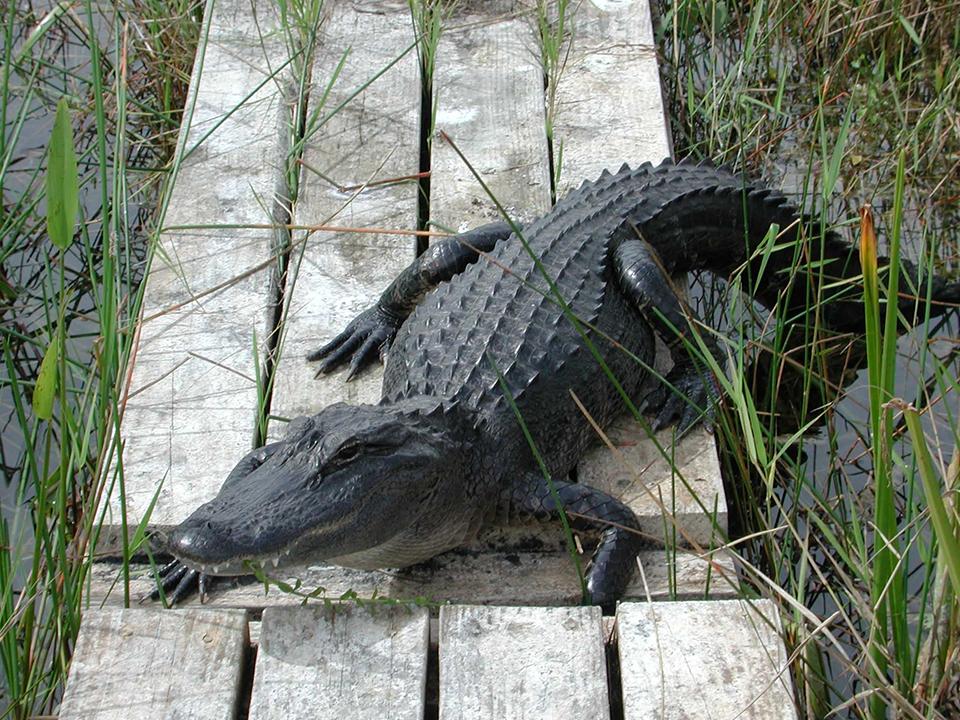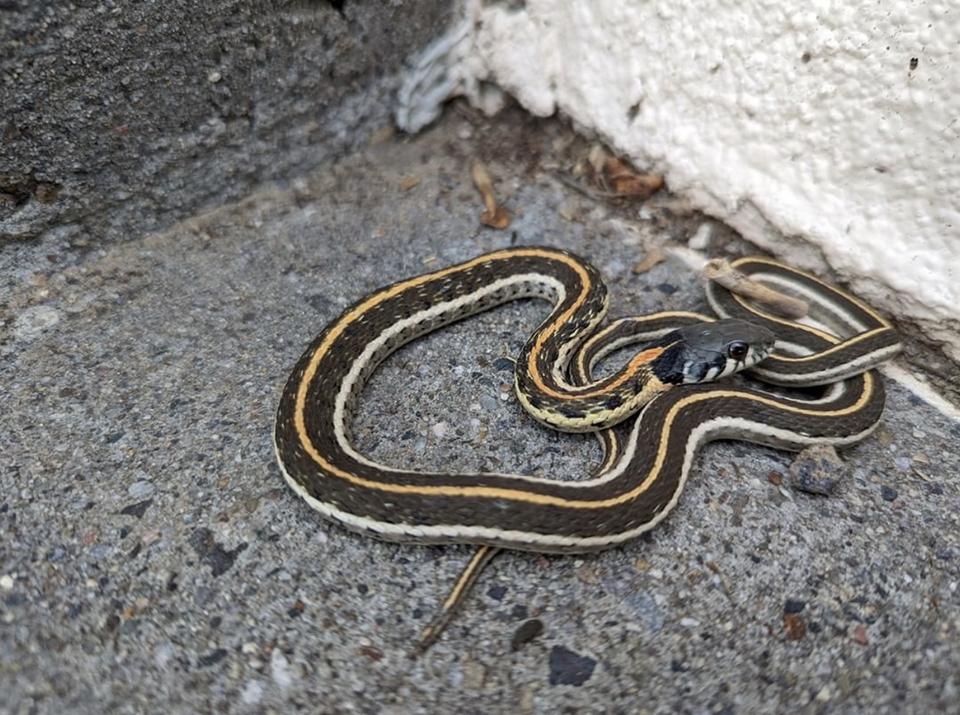
Steller's jay, Grand Canyon National Park / Rebecca Latson
With 423 units of the National Park System from which to choose, there will never be a shortage of questions and interesting trivia to test your knowledge and provide you with a fact or two you can use to impress family, friends, and colleagues. See how much you really know before reviewing the answers at the bottom of the page.
1. The Steller’s jay can be found in many units within the National Park System: Bandelier National Monument and Mount Rainier, Rocky Mountain and Grand Canyon national parks, for example. While they are a blue bird, they are not a bluebird. The blue you see on their wings is known as ___.
a) structural color
b) melanin tone
c) diffraction grating
d) gene pigmentation

Sonoran gopher snake, White Sands National Park / NPS
2. One of the most common snakes you might see in White Sands National Park is the Sonoran gopher snake. This snake is one of ___ species found in the park based upon a reptile and amphibian inventory taken in the park between 2003 – 2004.
a) four
b) seven
c) nine
d) eleven

Watch your step! Alligator on the boardwalk, Everglades National Park / NPS - Fred Minderman
3. If you visit Everglades National Park, you might see an alligator or two. Those bony scales you see on the alligator are called ___.
a) lamella
b) plates
c) scutes
d) incrustations

California condor, Pinnacles National Park / NPS - Kurt Moses
4. While visiting Zion or Pinnacles national parks, you might be lucky enough to see an endangered California Condor. These creatures are one of North America’s largest birds, weighing up to ___ pounds.
a) 15
b) 25
c) 32
d) 41

Badger family, Badlands National Park / Glenda Mueller via sharetheexperience.org
5. While hiking around Badlands National Park in South Dakota, you might spy a badger family emerging from its den. Badgers are related to weasels, ferrets, otters, and ___.
a) beavers
b) wolverines
c) bears
d) prairie dogs

Pottery shards, Prince William Forest Park / NPS
6. While hiking around in Prince William Forest Park, you look down and “see an old bottle, a piece of a broken plate, or even an arrowhead.” True or False: once an object is 75 years old, it becomes eligible for protection as an archeological resource.
a) True
b) False
7. How many miles of the International Appalachian Trail (IAT) pass through Katahdin Woods and Waters National Monument?
a) 10
b) 20
c) 30
d) 40
8. If you’ve ever driven along Rim Rock Drive at Colorado National Monument, then you’ll know there are ___ tunnels along this road.
a) two
b) three
c) four
d) five
9. A visit to Lassen Volcanic National Park will afford you the chance to hike the 24-mile section of the Nobles Emigrant Trail, “pioneered in 1851 by William Nobles” as a shortcut between the Applegate Trail and Lassen Trail. The Nobles Emigrant Trail was also known as the ___.
a) Fort Kearney, South Pass, and Honey Lake Wagon Road
b) Humbolt River Wagon Road
c) Great Spur Wagon Road
d) Applegate Trail Wagon Road

An aerial view of Carey Kipuka, Craters of the Moon National Monument and Preserve / NPS
10. A trip to Craters of the Moon National Monument and Preserve means you’ll be hiking around, or perhaps even on, a kipuka – a Hawaiian term describing “pockets of older, more vegetated lava surrounded by younger lava flows.” There are more than ___ kipukas contained in this monument.
a) 500
b) 700
c) 900
d) 1,200
Trivia

Loading the cannon, Fort Stanwix National Monument / NPS
“Throughout the American Revolution, women participated in many ways. Some followed their husbands into war and worked as cooks, nurses, or laundresses … Women whose husbands and fathers served on cannon crews hauled water to cool down and clean the cannon barrels and for the crew members to drink. These women were sometimes given the nickname of ‘Molly Pitcher’ because they sometimes used pitchers to carry the water. Two of these women, Margaret Corbin and Mary Ludwig Hays, even helped serve on the cannon crews after their husbands were killed or wounded in battle.” If you happen to visit Fort Stanwix National Monument, you’ll see an exhibit entitled “Women & the Military: What is Service?” which explores the history of women’s interactions in the U.S. Armed Forces.

Beargrass along the Grinnell Glacier Trail, Glacier National Park / Rebecca Latson
As you hike the trails in Glacier National Park, you might come across a common wildflower known as beargrass, which typically begins blooming in late May and can last through August in the high country. “Beargrass can grow up to five feet in height with long and wiry, grass-like basal leaves at the base of the stalk and a cluster of small, dense white flowers at the top. But beargrass isn’t just interesting to look at – bears will use leaves as denning material and sheep, deer, elk and goats are known to eat beargrass for sustenance.”

Striped whipsnake, Aztec Ruins National Monument / NS - Nicoletta Browne
A hike along the trails at Aztec Ruins National Monument might bring you into contact with one of the national monument’s slithery inhabitants, the striped whipsnake, pictured above. This non-venomous species is common in the park. “It feeds on small animals including rodents, frogs, insects, and other snakes. There is quite a bit of color variation in their stripes.” If you happen to see a snake on or near the trail, keep your distance, let it be, let others know it is there, and report it to park staff so they can safely relocate it.
Quiz Answers
1a
The blue color seen on the wings of Steller’s jays is known as structural color: “blue wavelengths of light reflecting off pockets of air and protein fibers trapped within the feather cells … Steller’s and blue jays belong to the genus Cyanocitta … derived from Greek words meaning ‘dark blue’ and ‘chattering bird.’”
2d
Based upon the 2003-2004 survey of reptiles and amphibians found within White Sands National Park, there are eleven species of snakes. To read more about this survey and what was found, click here.
3c
Well, each of the choices would work as synonyms for the scales seen on an alligator, but the correct term is scutes. According to the NPS, “A ‘gator’s scutes serve a multitude of purposes, from protection to camouflage, tactilocation, thermoregulation, and streamlining.”
4b
California condors are one of North America’s largest birds, weighing up to 25 pounds with a 9.5-foot wingspan. “In 1982, there were only 23 condors in the world. Today, the total free-flying and captive population consists of more than 500 condors, and there are more California condors in the wild than in captivity.”
5b
Badgers are related to weasels, ferrets, otters, and wolverines. “They live in underground burrow systems called ‘setts.’ On average, about six badgers live in one sett … A badger can run up to 19 mph (30.6 kph) for a short period of time.”
6b False
“Once an object is 50 years old (that’s now as recent as 1972), it becomes eligible for protection as an archeological resource.” So, if you think you’ve found something that looks old enough to be an artifact, please don’t move it. Leave the object in place and tell a ranger about it.
7c
“In Maine, the IAT starts in Katahdin Woods & Waters National Monument in the U.S. State of Maine, and 30 miles of the trail pass through this national monument. The trail heads northeast along the East Branch of the Penobscot River and then east towards Mount Chase and, eventually, Houlton. At Houlton, the trail turns north again and continues to Mars Hill Mountain in Aroostook County. It follows the United States/Canadian international border northward to Fort Fairfield where it crosses into Perth-Andover, New Brunswick.” To learn more about the IAT, click here.
8b
“Colorado National Monument has three tunnels on Rim Rock Drive: two tunnels on the west side and one on the east side of the park. Remember to keep your vehicle lights and/or bicycle lights on while traveling through the tunnels.”
9a
The Nobles Emigrant Trail was also called the Fort Kearney, South Pass, and Honey Lake Wagon Road.
10a
There are more than 500 kipukas contained in Craters of the Moon National Monument and Preserve. To read more about these landforms, click here.
References
In addition to information taken from the NPS website and various park unit Instagram sites, the following links were used as references for this quiz and trivia piece.




 Support Essential Coverage of Essential Places
Support Essential Coverage of Essential Places






